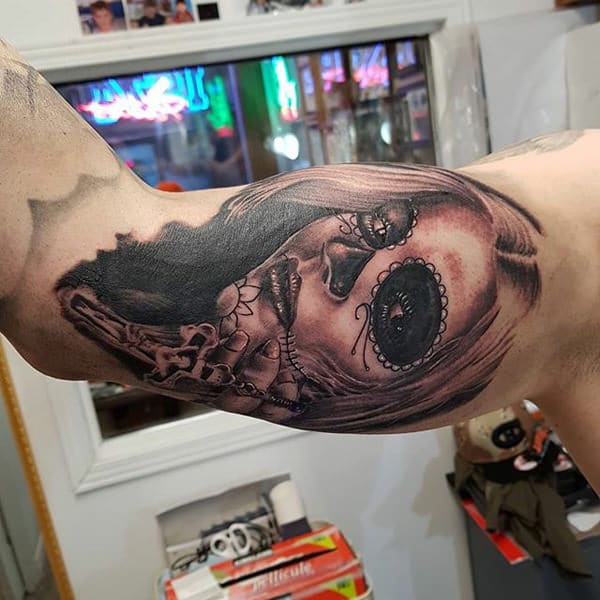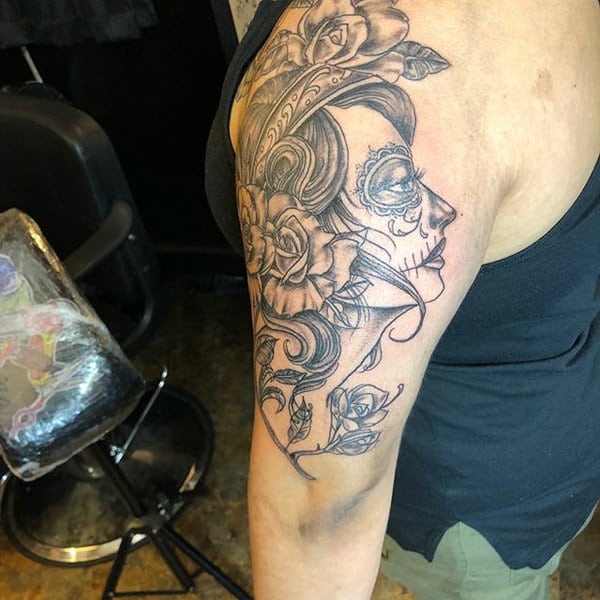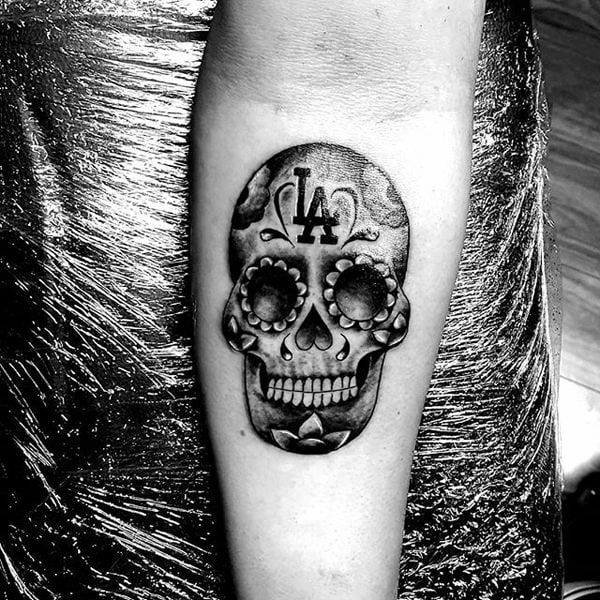Tattoos are an art form that promotes self-expression while retaining the uniqueness of the wearer. However, like all other art forms, it is also drenched in culture, belief, and tradition. You might come across someone who is sporting a skull on their forearm and admire it as a work of art without understanding what it depicts.
A non-tattoo enthusiast may not understand what such a tattoo means but if you are looking into getting something similar, then comprehending the actual beliefs and meaning attached to it certainly helps. For ages, the tradition of tattooing has been carried out by indigenous tribes, and in most cultures, they are seen as a necessity that binds the wearer to his/her roots.
However, in the western world, tattoos were not viewed as a choice till after the 18th century. In some cases, tattoos were a symbol used to mark criminals that were on death row. This concept has eventually evolved to a somewhat acceptable status, and most non-tattoo enthusiasts view this as a fashion statement or self-expression.
The most important thing, however, is to understand that getting a tattoo is a journey and not just mimicry of someone else’s fashion statement. Once you decide to get inked, you are bound to conduct your research and spend time evaluating your choices.
































For people who get tattooed for the first time in their lives, their choice often changes over the course of their research. They will start out with a specific tattoo in mind and end up getting an entirely different one. Designs and ink should resonate with the thought process that goes on within an individual unless you are a die-hard fan who just wants to copy a tattoo that your icon has, you will most likely have a meaning attached to your tattoo design.
Various factors can affect this choice. Your budget, your pain tolerance, the history and true meaning of a specific design and whether it translates your mindset onto the canvas that is your body.
The most crucial part is understanding the “life” of the design. It will stay with you forever and gradually people will start identifying you referring to your tattoo, well unless it is hidden from view. Meaningless tattoos often turn to regrets as the mind matures and your perception of the world around you changes. If you are reading this, then you are not getting a tattoo as a spur of the moment choice – which is good in hindsight as your tattoo will have a meaning attached to it. To better understand what the day of dead tattoos convey, we have compiled all the necessary information our readers will require

Day of the dead tattoos on arms















































The Day of the dead and Tattoos
Contents
Dia de Los Muertos or the Day of the Dead is a celebration that comes up at the end of October and lasts a couple of days. In short, the celebration of the people who have passed on is observed the same day as Halloween. But the beliefs and culture attached to this holiday transcend anything that Halloween stands for.
Halloween itself has had a great influence on the basic celebration rituals of this Mexican holiday. Initially, this holiday was celebrated during August, but due to the concept and theme being similar, Halloween and the day of the dead both fall on Oct 31st. The day of the dead celebrations ends on the 2nd of November making it a 3day festival. While Halloween has its roots deeply seated in England, Dia de Los Muertos is a purely Mexican holiday that entwines Aztec beliefs with Mexican culture.
This celebration represents the loved ones and ancestors who have left this world behind. There are songs, dance, food and gatherings that signify the importance of the dead in Mexican culture. The celebration begins similarly to that of Halloween by celebrating “All Hallows Eve.” The next day, commonly referred to as “All Saints Day” brings a celebration for saints or adults who are deceased. Altars are set up on Nov 1st to honor those adults who have passed away from the community. On the 2nd of Nov “All Souls Day” is celebrated.
However, beliefs vary throughout the community, and some believe that Nov 1st is all souls day and not Nov 2nd. Nevertheless, the day of the dead is a 3-day celebration that honors all those who have passed away and the spirit world.
















Tattoos
Like many other beliefs and traditions before this, culture has remained vital to the world of art and body modification. The day of the dead has also impacted the tattoo world, and you will find some designs affected by the celebration of death.
The most elaborate and adopted tattoo art inspired by the day of the dead features La Calaveras Catrina also referred to as the Lady of the Dead. Roses, intricate jewel designs, Sugar skulls, and skeletons are a considerable part of this inspiration.
While a skull or a skeleton tattoo may not be the initial choice for beginners; understanding the philosophy behind these works of art can change anyone’s mind. Skeletons and skulls bear great honor and respect and various cultures. According to these beliefs, skulls and skeletons are the remains of life, a mark of sorts that is left by an individual who has spent a lifetime on this Earth.
In other beliefs, the skull is seen as a negative omen, a representation of negative energy, death, and sorrow. But for Mexicans, their belief dictates otherwise. The most commonly inked tattoo’s design there is the “sugar skull.” This design is embedded on the tombstones of deceased family members and loved ones who have moved on to the spirit world after leaving their mark on this planet.
The tombstones are decorated with sugar skulls on the day of the actual celebrations. That is why most days of the dead tattoos are inspired by the sugar skull design. `The image is almost always that of a woman. This inspiration stems from the celebration of the Mexican Goddess. The candied skull variations of Catrina are usually brightly colored. They are skulls, but further from being creepy or scary. The fun part is that these candied versions have a cheerful design and colorful details that give a sense of happiness rather than bring the sorrow of death.














Also See:
- 13 Best Tattoo Shops in The World
- 155 Rose Tattoos: Everything You Should Know (with Meanings)
- 125 Awesome Crow/Raven Tattoo Ideas and their Meanings
- 125 Stunning Feather Tattoos to Choose From
- 155 Sugar Skull Tattoo Designs with Meaning
Types of “The Day of the Dead” tattoos
Most designs center around a skull immersed in jewels or roses, others, however, can be real-life inspirations taken from those who have departed.
1. Portrait skulls
Portrait skulls are inspired by a departed loved one. Their image is transferred onto skin and then enhanced using the Calavera makeup that turns it into a sugar skull. That is done to honor the loved one who is no more. While some fans go as far as getting a celebrity portrait inked onto their bodies, most people will traditionally only do this for blood relations and family. These are memorial tributes drawn mostly over the chest the back and the upper arm. These portraits are enhanced and made a symbol of death by adding deep dark circles around the eyes, a dark triangle, where the nose is and a hollowed out cheek area. These portraits are mostly colored.
2. Black sugar skulls and skeleton tattoos.
These tattoos have death and bones at the center of the design. They are enhanced by using symbols such as roses, owls or even clocks to signify the running out of time and the presence of mortality. Most of the darker versions are usually just outlines shaded where necessary. In some designs, there is the use of weapons and other hazardous elements that may be specific to the death of the loved on shown in the portrait or tattoo.
3. Decadent in death
These tattoos are a mix of colored designs and all black portraits. You will find some aspects of the tattoo are elegant and eye-catching colors that signify the happiness and “partying” in the afterlife. Most of these designs depict a little color poncho or a sombrero. They are placed on the back of the hands or behind the ears.
















Traditional specifications of the day of the dead tattoos
There are certain aspects of these skull tattoos that highlight their relationship to the day of the dead tattoos.
Thread:
The portraits that depict faces or skulls should either show the teeth of the face exposed through the skull, if not then the mouth needs to be sewn shut using a thread.
Marigolds:
Also referred to as the Cempasuchtl in Mexico, the petals from these flowers create a path that leads the departed soul to its loved ones on Earth.
Ofrenda:
That translates to the word altar, tattoos designed using ofrenda contain all the four elements, earth, wind, water, and fire. These are shown as symbols in the actual tattoo. You will see a skull shedding tears or its hair flying in the wind.
















Conclusion
The day of the dead tattoos is strictly a cultural affair. Even the colors used in these designs have significance. If you are looking to honor a loved one who has departed, then this is the design for you.

